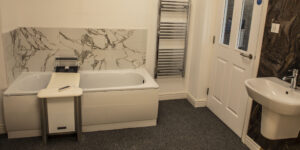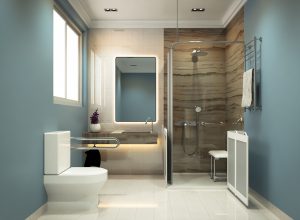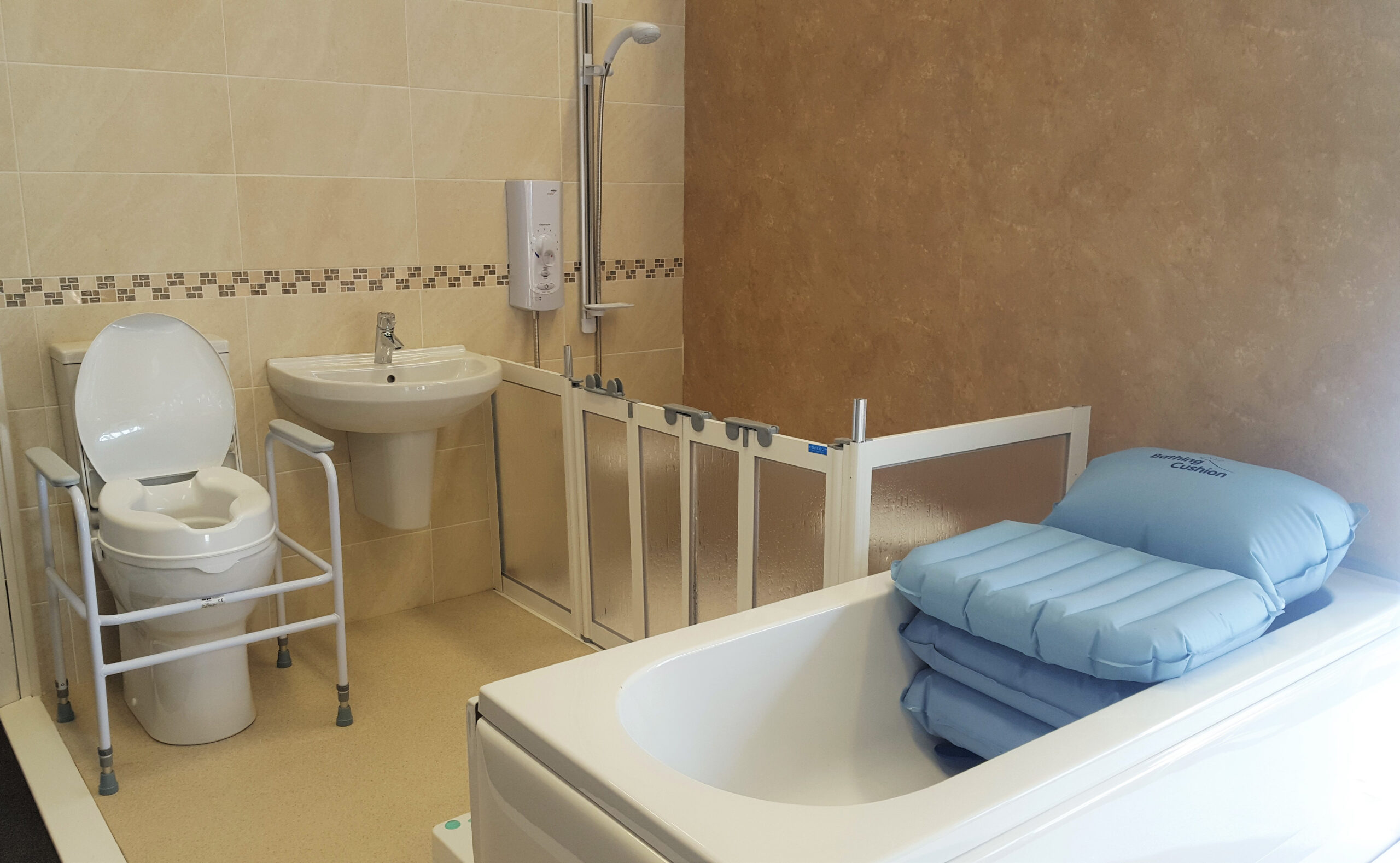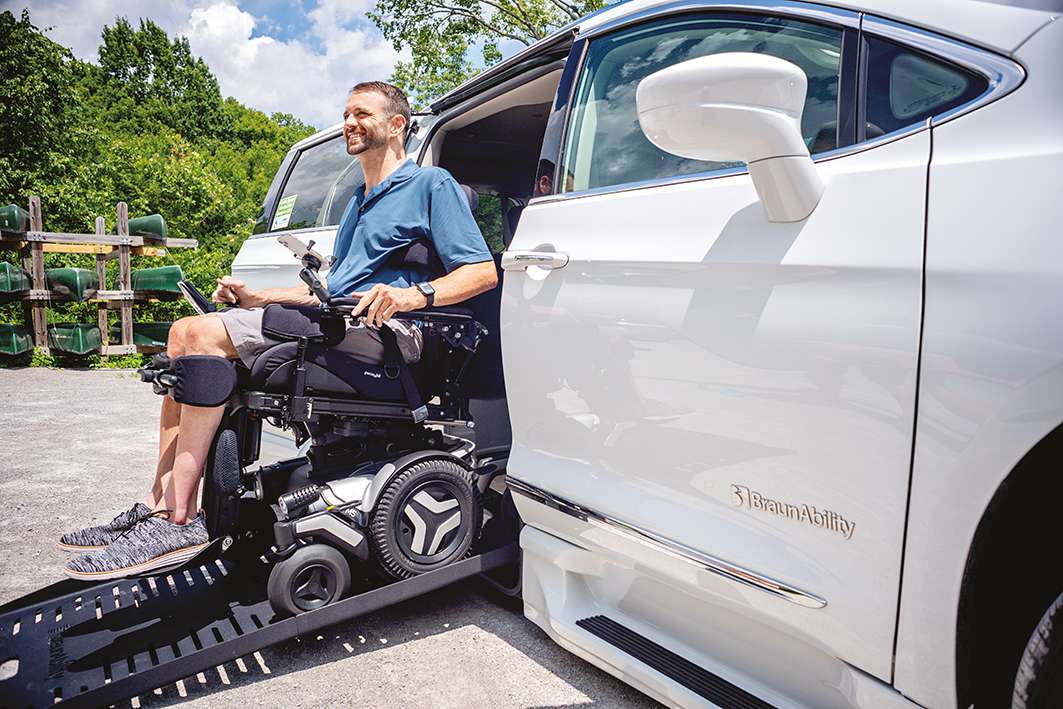Making sure your bathroom is as easy-to-use as possible for disabled individuals is a challenge. What with the need to think about slippery surfaces, accessible showers, and maybe even a specialist toilet, bathrooms can be a bit more daunting when looking at accessibility.
We’ve thought up 5 ways for you to make accessible bathrooms depending on varying levels of mobility and capability.
Jump straight to…
- General accessibility and safety
- Bring the shower to them
- Bathlifts and Hoists
- Specialist Toilets
- Wetroom adaptations
- Summary
1 ) General accessibility and safety
The bathroom can be one of the most difficult environments to navigate in your home. Having very little to hold on to as well as wet surfaces can be a disastrous combination – particularly for someone who is unsteady on their feet.
If the individual is unstable on their feet, then grab rails are a great way to promote safety and stability in the bathroom. Positioning them at specific locations (i.e. – on the wall of the shower at a safe height for the user) will help the person by providing extra things to hold on to, as well as giving them peace of mind that they have support available if necessary.
Grip strips for the bath and shower tray are also a good way to give the individual a sense of security. These safety strips can be stuck to the base of the bathtub or the shower tray to provide extra grip to stop the user from slipping.
If the person you are caring for struggles to stay standing up for long periods of time, it might be worth investing in a shower chair. This means that the individual can relax at when showering and not have to worry about standing up or falling.
Bath mats are another easy way to give the person a stronger sense of security when they’re on their feet.
2) Bring the shower to them
This may seem like an odd solution; the sheer chaotic image of showering someone in an armchair! However, it can be done in a pretty straightforward, simple way.
For example, if the bathroom is upstairs but the individual is confined to the downstairs level of the house, you don’t have to install a stairlift to be able to use the loo.
Shower cubicles (also referred to as shower pods) are an excellent option if you’re looking to have an accessible bathroom in a convenient location. They can be put up with ease and can include a shower, toilet, and sink.
This means that the user can wash with dignity in a convenient place. These shower cubicles can also be taken down when no longer needed, offering the individual an accessible bathroom for as long as they need it.
3) Bathlifts and hoists
Getting in and out of the bath can be the trickiest thing in the bathroom. Accessing the bath is hard for people with less body strength or a physical disability, but there are ways to make it easier.
Bathlifts and hoists are ideal for increasing accessibility.
Bathlifts are attached to the tub and offer the user a secure, stable way to get in and out of the bath. They can either feature a belt that spans the width of the bath and slowly lowers the user into it, or they can be shaped like a seat to give more upper body support to people who need it.
These are more permanent ways to ensure accessibility and safety in the bathroom.
Hoists are ideal for users who need more physical support. If the individual has limited lower body strength and needs extra trunk support, a hoist is the best way to make sure that they can access the bath with ease and without compromising their security.
4) Specialist toilets
Accessibility can be improved by using specialist equipment. Specialist toilets are a great way to simplify an everyday task so that the individual can retain their dignity whilst enjoying a relaxing experience.
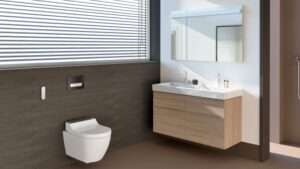
The Geberit Aquaclean wash-dry toilet would be a great way to make a bathroom more accessible. Combining basic toilet functions with bidet features, this wash dry toilet makes sure the user leaves the seat feeling clean.
With a variety of rinsing motions and temperature settings, the Geberit Aquaclean wash-dry toilet is a great way to increase bathroom accessibility for people who may require more support when using the loo.
5) Wetroom adaptations
Arguably the most permanent step to take, a bathroom or wetroom adaptation is the most effective way of ensuring that your bathroom is as accessible as it can be. Our wetroom adaptation service also covers the design of the room to make sure that we put in everything you could possibly require to make it as accessible as possible.
We can install level access showers and baths, as well as height adjustable sinks that give good access to wheelchair-users.
We can come and look at your home on a free no-obligation site survey to determine exactly what it is you want and how we can use the space you have. Just give us a call to arrange one!
Summary
Bathrooms might seem like a difficult environment to make accessible or wheelchair-friendly, but it doesn’t have to be so complicated. From grip strips to level access showers, there are ways to make sure that the individual can access everything in the bathroom with ease and dignity.
We’re on hand if you need any advice to do with bathroom adaptations or any other bathroom or toileting equipment, just get in touch!
Frequently Asked Questions
Q: What are the easiest ways to improve bathroom safety for someone with limited mobility?
A: Start with simple safety upgrades like installing grab rails, non-slip mats, shower chairs, and grip strips in baths or showers. These are affordable and effective changes that help reduce the risk of falls and increase confidence while using the bathroom.
Q: What is a shower pod or shower cubicle, and how does it help?
A: A shower pod (also known as a shower cubicle) is a freestanding, self-contained unit that includes a shower—and sometimes even a toilet and sink. It’s ideal when someone can’t access an upstairs bathroom, offering a temporary but fully functional accessible bathroom downstairs without major renovations.
Q: What’s the difference between a bathlift and a hoist?
A: A bathlift is fitted inside the tub and gently lowers and raises the user into the water. It can be seat-based or belt-based.
A hoist offers more comprehensive support for users with severe mobility challenges, transferring them safely in and out of the bath, often with help from a carer.
Both help users bathe safely and comfortably depending on their mobility needs.
Q: How can a specialist toilet improve bathroom accessibility?
A: Specialist toilets like the Geberit Aquaclean wash-dry toilet combine standard toilet functionality with bidet-style cleaning and drying, promoting hygiene and independence. These are particularly useful for individuals who may struggle with personal care but still want to maintain dignity.


